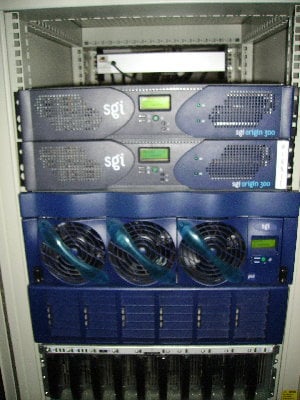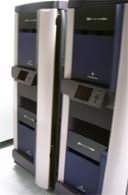Edit:
Read all the way through the thread. Both systems are now NUMA linked.
It is the top one..
I have a question.
Am I at a point now where I need a router boad..?
There is a NUMA link cable from minnie to the Px brick (12 PCI slots)..
Can I NUMA link the two Origin300s directly or do I need to route between all three modules..?
The other Origin (minnie) and the PCI expansion module (Px brick) can be found here:
viewtopic.php?f=14&t=11542
Regan
Code: Select all
>> hinv -v -m -mvvv
IP35 Node Board, Module 001c01
ASIC BEDROCK Rev 2, 200 MHz, (nasid 0)
Processor A: 500 MHz R14000 Rev 2.4
Secondary Cache 2MB 250MHz Tap 0xa , (cpu 0)
R14010FPC Rev 2.4
Processor B: 500 MHz R14000 Rev 2.4
Secondary Cache 2MB 250MHz Tap 0xa , (cpu 1)
R14010FPC Rev 2.4
Processor C: 500 MHz R14000 Rev 2.4
Secondary Cache 2MB 250MHz Tap 0xa , (cpu 2)
R14010FPC Rev 2.4
Processor D: 500 MHz R14000 Rev 2.4
Secondary Cache 2MB 250MHz Tap 0xa , (cpu 3)
R14010FPC Rev 2.4
Memory on board, 4096 MBytes (Standard)
Bank 0, 1024 MBytes (Premium) <-- (Software Bank 0)
Bank 1, 1024 MBytes (Premium)
Bank 2, 1024 MBytes (Premium)
Bank 3, 1024 MBytes (Premium)
IBRICK Bridge, Module 001c01
ASIC BRIDGE Rev 2, (widget 14)
adapter PCI (SCSI interface) Rev 6, (pci id 2)
IBRICK Bridge, Module 001c01
ASIC BRIDGE Rev 2, (widget 15)
adapter PCI (SCSI interface) Rev 6, (pci id 1)
adapter IOC3 Rev 1, (pci id 4)
controller multi function SuperIO
controller Ethernet Rev 1
adapter USB (OHCI interface) , (pci id 5)
ASIC XBOW Rev 2, on CBrick, Module 001c01
>>
It is the top one..
I have a question.
Am I at a point now where I need a router boad..?
There is a NUMA link cable from minnie to the Px brick (12 PCI slots)..
Can I NUMA link the two Origin300s directly or do I need to route between all three modules..?
The other Origin (minnie) and the PCI expansion module (Px brick) can be found here:
viewtopic.php?f=14&t=11542
Regan



















 J5600, 2 x SUN, 2 x Mac, 3 x Alpha, 2 x RS/6000
J5600, 2 x SUN, 2 x Mac, 3 x Alpha, 2 x RS/6000






